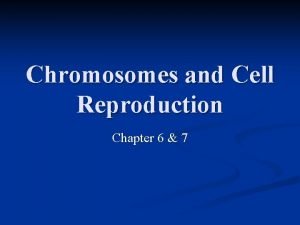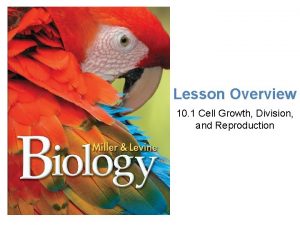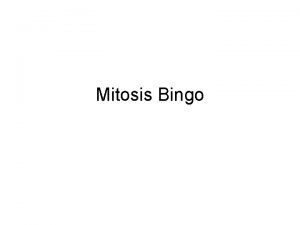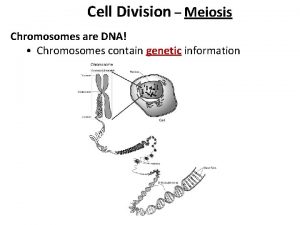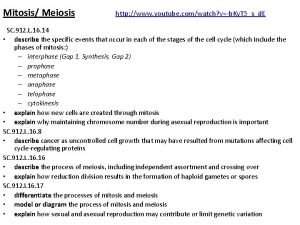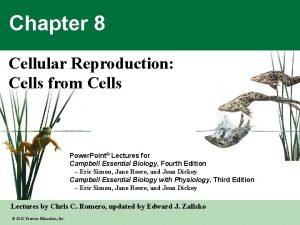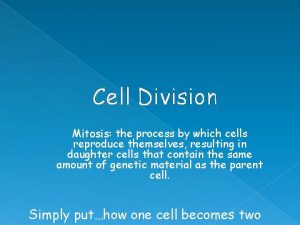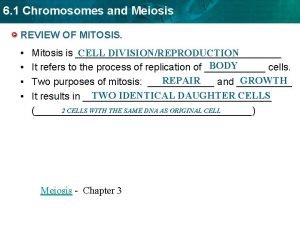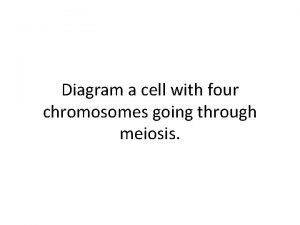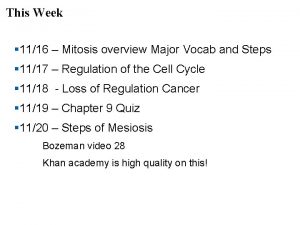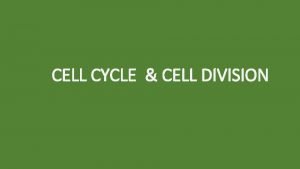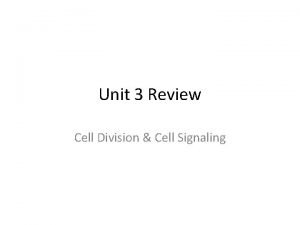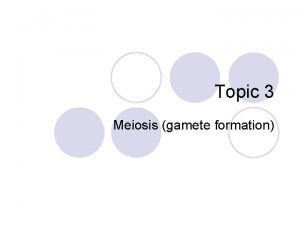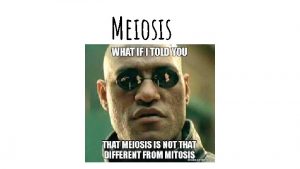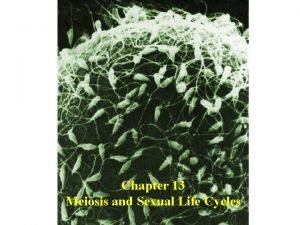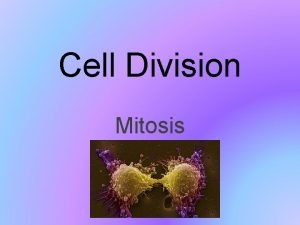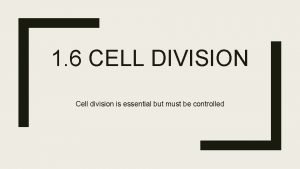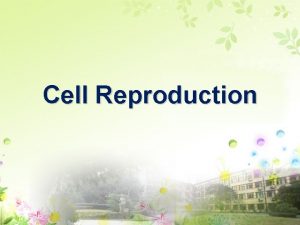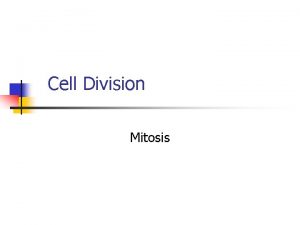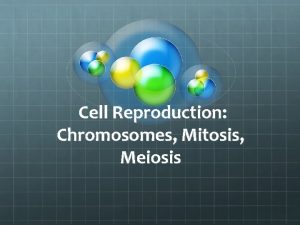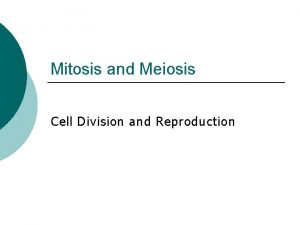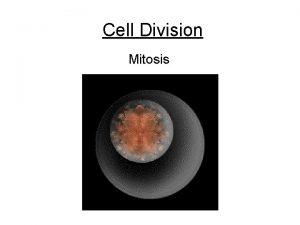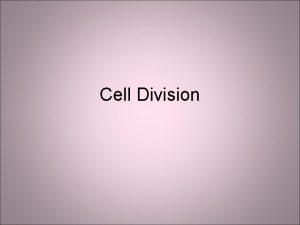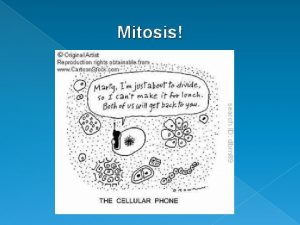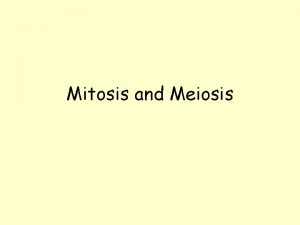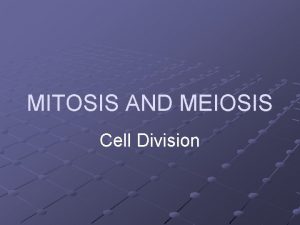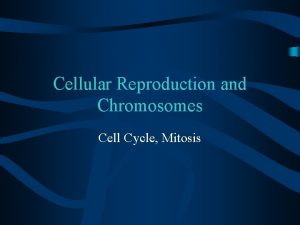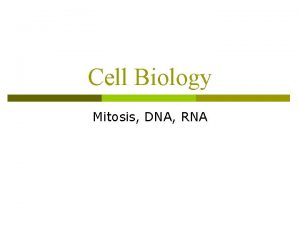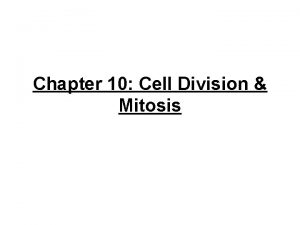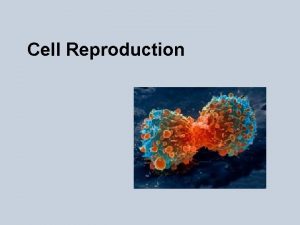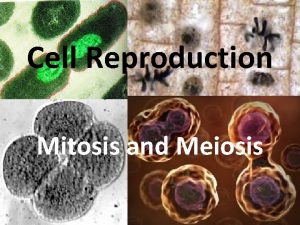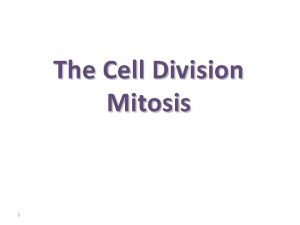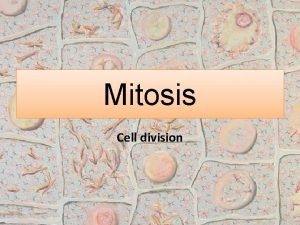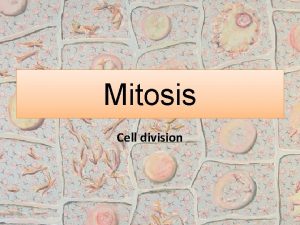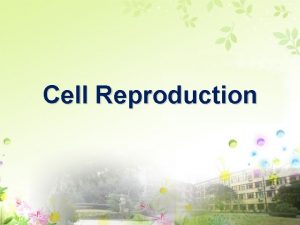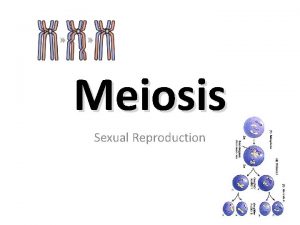Chromosomes and Cell Reproduction Cell Division Mitosis Chromosomes





























- Slides: 29

Chromosomes and Cell Reproduction Cell Division: Mitosis

Chromosomes and Cell Reproduction NEW CELLS ARE FORMED BY CELL DIVISION p Gene – section of a chromosome that codes for a protein or RNA molecule. p Chromosome –Structure made of DNA molecule and associated proteins on which genes are located. DNA coiling http: //www. biostudio. com/demo_freeman_dna_coiling. htm

Chromosomes and Cell Reproduction NEW CELLS ARE FORMED BY CELL DIVISION p Chromatids - a pair of strands of DNA that make up a chromosome during mitosis and meiosis. p Centromere – a region joining two chromatids.

Chromosomes and Cell Reproduction NEW CELLS ARE FORMED BY CELL DIVISION

Chromosomes and Cell Reproduction

Chromosomes and Cell Reproduction p Multicellular organisms grow, repair and develop tissues by cellular division. p Newly formed cells replace old, damaged, or worn out cells.

Chromosomes and Cell Reproduction

Chromosomes and Cell Reproduction NEW CELLS ARE FORMED BY CELL DIVISION p Unicellular organisms like bacteria reproduce by simple cell division called Binary Fission. p Binary Fission – a form of asexual reproduction that produces identical offspring.

Chromosomes and Cell Reproduction Eukaryotic cells form chromosomes before cell division Before cell division occurs, DNA is first copied. The copied DNA coils and condenses into visible (under a microscope) chromosomes.

Chromosomes and Cell Reproduction CHROMOSOME NUMBER AND STRUCTURE AFFECT DEVELOPMENT p Homologous Chromosomes – a member of a chromosome pair, both of which are similar in shape, size, and the genes that they carry. They are corresponding chromosomes, one from each parent, which contain the same genes.

Chromosomes and Cell Reproduction CHROMOSOME NUMBER AND STRUCTURE AFFECT DEVELOPMENT p Diploid – a term used to indicate a cell containing two sets of chromosomes (2 n), one set inherited from each parent. Ex. Humans 2 n = 46 p Haploid – having only on set of chromosomes. Ex. Humans n = 23. p Gametes – haploid cell that participates in fertilization by fusing with another haploid cell. Reproductive cells (sex cells). Ex. Sperm and Egg. p Zygote – a fertilized egg cell. 2 n = 46.

Chromosomes and Cell Reproduction CHROMOSOME NUMBER AND STRUCTURE AFFECT DEVELOPMENT p The Haploid Number (n) of chromosomes in humans haploid number (n) is 23. In other organisms (species) this number will vary. p The Haploid number (n) of chromosomes is found in only sex cells (gametes). p Somatic cells (body cells) have diploid number (2 n). In humans the diploid number (2 n) is 46. This means we have 46 chromosomes total or we have 23 pairs of chromosomes.

Chromosomes and Cell Reproduction CHROMOSOME NUMBER AND STRUCTURE AFFECT DEVELOPMENT p Successful fertilization requires not only that a sperm and egg fuse, but also that no more than one sperm fuses with the egg. p Fertilization by more than one sperm - polyspermy - almost inevitably leads to early embryonic death.

Chromosomes and Cell Reproduction CHROMOSOME NUMBER AND STRUCTURE AFFECT DEVELOPMENT p n (haploid) + n (haploid) = 2 n (Diploid) egg + sperm = Zygote* p *A zygote has the same number of chromosomes as a normal body cell (somatic cell). p Human: 23 + 23 =46 p Upon fertilization a zygote will undergo cell division. And develop into an embryo, which will undergo cell differentiation.

Chromosomes and Cell Reproduction CHROMOSOME NUMBER AND STRUCTURE AFFECT DEVELOPMENT p Cell Cycle – repeating five-phase sequence of eukaryotic cell growth and division. p Interphase – period between two mitotic or meiotic divisions of eukaryotic cell during which the cell carries out routine functioning, copies its DNA, and prepares to divide. p Cytokinesis – division of the cytoplasm to form two separate cells.

Mitosis is the Process by which cell nucleus divides into 2 nuclei with identical chromosomes. After Mitosis the cell divides. Cell grows in size but does not divide. G 1 Phase Preparations are made for nuclear (mitotic) division. Spindle apparatus made up of microtubules is constructed. G 2 Phase DNA is copied and condenses into chromosomes made of two chromatid attached at a centromere. S Phase

Chromosomes and Cell Reproduction Cell Cycle p Animations n http: //nobelprize. org/medicine/educational/2001/cellcycle. html n http: //www. wisc-online. com/objects/index. asp? obj. ID=AP 13604

Chromosomes and Cell Reproduction CHROMOSOME NUMBER AND STRUCTURE AFFECT DEVELOPMENT p Cancer – a disease characterized by abnormal cell growth.

Chromosomes and Cell Reproduction CHROMOSOME NUMBER AND STRUCTURE AFFECT DEVELOPMENT p Cancer cells don't stop reproducing. Unlike normal cells, cancer cells do not stop reproducing after they have doubled 50 or 60 times. p This means that a cancer cell will go on and on doubling. So one cell becomes two, then four, then eight, then sixteen. . They may be more resistent to self destruction than normal cells, or they may self destruct more slowly than they reproduce. p Eventually a tumor is formed that is made up of billions of copies of the original cancerous cell. Scientists describe cancer cells as being 'immortal'.

Chromosomes and Cell Reproduction IN MITOSIS, CHROMATIDS ARE PULLED BY MICROTUBULES p Spindles – structures composed of centrioles and individual hollow protein fibers that moves chromosomes apart during cell division.

Chromosomes and Cell Reproduction p Chromosomes become visible. p Nuclear Membrane disappears. p Spindle apparatus forms.

Chromosomes and Cell Reproduction p With the aid of the spindle apparatus the chromosomes line up at the equator of the cell.

Chromosomes and Cell Reproduction p Centromeres divide. Chromatids separate. p Chromatids now called chromosomes are pulled to opposite poles of the cell by the spindle apparatus.

Chromosomes and Cell Reproduction p Nuclear Membrane forms at each pole. p Chromosomes begin to uncoil. p Spindle apparatus dissolves. p Cytokinesis begins. Cytoplasm Splits. Two newly formed cells.


Chromosomes and Cell Reproduction PLANT MITOSIS, A LITTLE DIFFERENT p Mitosis in plants occurs mainly at the tips of growth above and below ground. p Plant cells form a cell plate but animal cells “pinch in” from the outside during telophase. p The cell wall is enzymatically “softened” prior to division. p Plants form a spindle apparatus as animals do but plants lack centrioles. p Instead of furrowing, vesicles derived from golgi apparatus fuse at the equator to form a cell plate. p The vesicles contain materials necessary to construct a cell wall between the cells.

Chromosomes and Cell Reproduction PLANT MITOSIS, A LITTLE DIFFERENT

Chromosomes and Cell Reproduction PLANT MITOSIS, A LITTLE DIFFERENT Plant cell division differs from animal cell division in two ways: n Plants do not have centrioles therefore no asters (still have spindles). n The rigid cell wall prevents the cell membrane from pinching; instead, a cell plate forms which divides the cell in half.

Chromosomes and Cell Reproduction PLANT MITOSIS, A LITTLE DIFFERENT
 Chapter 6 chromosomes and cell reproduction
Chapter 6 chromosomes and cell reproduction Cell growth division and reproduction
Cell growth division and reproduction Mitosis meiosis
Mitosis meiosis Two cells are produced
Two cells are produced Is mitosis asexual
Is mitosis asexual Binary fission in bacteria
Binary fission in bacteria Mitosis
Mitosis Asexualk
Asexualk Does meiosis occur in humans
Does meiosis occur in humans Asexual vs sexual reproduction venn diagram
Asexual vs sexual reproduction venn diagram Section 10-2 cell division
Section 10-2 cell division Cell cycle and cell division
Cell cycle and cell division Cell cycle phases in order
Cell cycle phases in order Independent assortment meiosis
Independent assortment meiosis Meiosis and mitosis
Meiosis and mitosis Non disjunction in meiosis 1 and 2
Non disjunction in meiosis 1 and 2 Example of anaphase
Example of anaphase Chromosomes number is maintained mitosis or meiosis
Chromosomes number is maintained mitosis or meiosis Diagram a cell with 4 chromosomes going through meiosis
Diagram a cell with 4 chromosomes going through meiosis Painting
Painting Significant
Significant Mitosis division
Mitosis division Mitosis division
Mitosis division Mitosis division
Mitosis division Human development cycle
Human development cycle Mitosis division
Mitosis division Mitosis division
Mitosis division Mitosis division
Mitosis division Long division and short division
Long division and short division Long division terms
Long division terms
